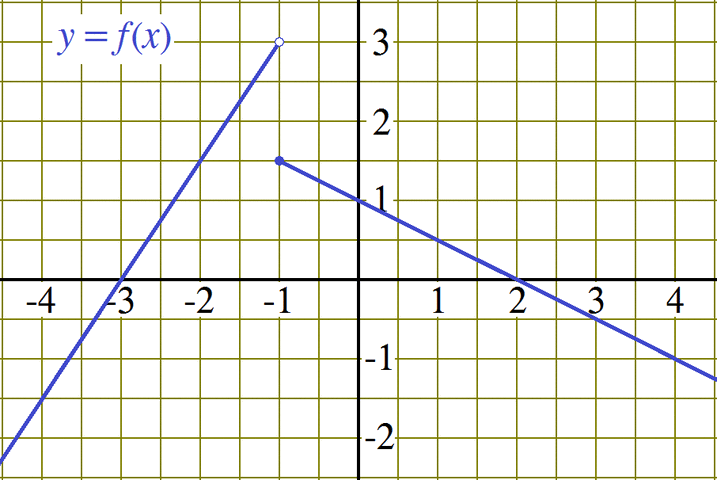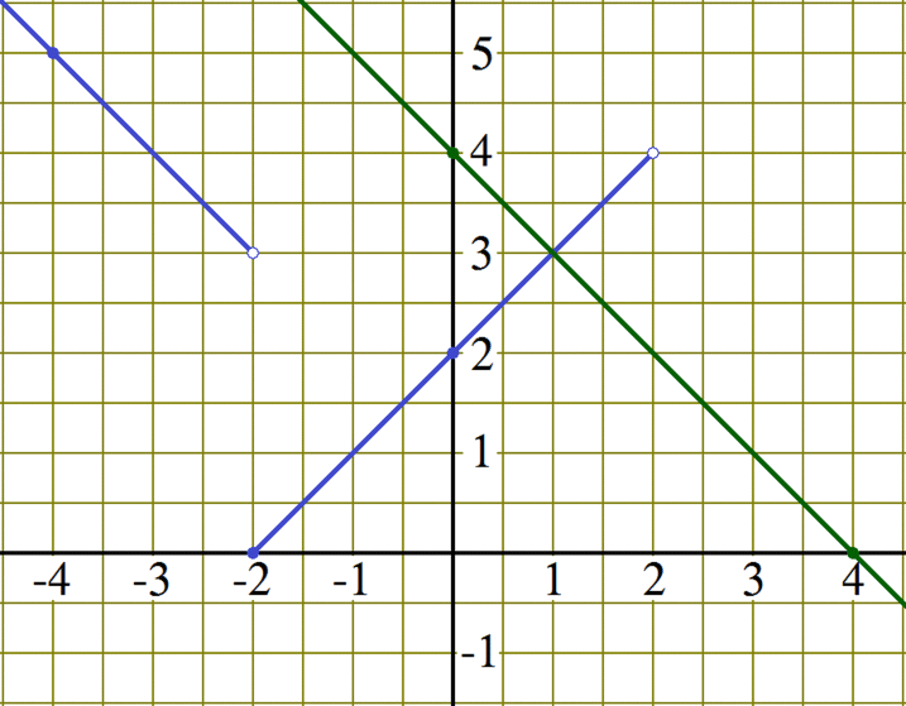Piecewise Defined FunctionsObjectivesThe concepts and techniques presented in this lesson will enable you to:
IntroductionNot all functions can be represented by a single formula. There is a whole class of functions called piecewise defined functions for which different formulas are used for different inputs. Such functions are used for cab fares, parking lot fees, income taxes, and monthly cell phone charges among others. So-called progressive income tax rates gradually increase as the annual income increases. Consider a machine which calculates the annual income tax owed for a given net income.
The income tax rates in one territory are presented as follows:
According to this tax rate scheme, the income tax for a resident whose net income was $20,000 for the
tax year would be 7% of the net income over $5,000, that is,
0.07 × ($20,000 − $5,000) = $1,050. The graph shown below represents the income tax function corresponding to the rates listed:
The abrupt changes in the previous graph make it impossible to write a single simple arithmetic process (a formula) that can be applied to every input. We already calculated the income tax due (the output) for different net incomes (inputs) and we used pretty basic arithmetic. While we didn't follow the same arithmetic process for each net income, we were able to figure out what process to use depending on the net income. We can write a list of those arithmetic processes (formulas) and the net incomes (inputs) for which each of them applies. We could write that list as follows: This defines the income tax function in pieces, listing the different formulas to be applied according to the interval to which the input belongs. Literally the function is defined in pieces: one formula for inputs that are less than or equal to 5000, a second for inputs that are greater than 5000 and less than 22000, and so on. We call this a piecewise defined function. When the graphs of functions show abrupt changes like the graph above, we usually need different formulas for different pieces of the function.
The absolute value function is a piecewise defined function: If you are looking at this multi-part definition of the absolute value function and
thinking that |x| is always x, then you are
assuming that x itself has to be positive. For the definition to include all
real numbers, x has to represent negative numbers like −10
as well as positive numbers. So, how do we remove the negative sign if we can't see it? GraphsThe graph of a piecewise defined function works pretty much the same way as the graph of any other function. The only detail that may be a bit different is the use of oversized circles at certain points on the graph. A filled circle is used to show that the graph includes the corresponding point and that this portion of the graph begins or ends at this particular point. An unfilled circle is used to indicate that a portion of the graph begins or ends at the corresponding point, but does not actually include the point itself. Consider the following graph.
Using the graph above, evaluating the function f
at various inputs yields: Now, f (−1) = 1.5, f (−0.98) = 1.49, and f (−1.02) = 2.97. Can you evaluate f (3.5)? Given that the corresponding portion of the graph is a line segment, the value of f (3.5) should be in the middle of the values for f (3) and f (4). Why? Using the same graph, we can find the inputs that generate a given output: Click to practice evaluating piecewise functions represented by a graph:
FormulasWhen evaluating a piecewise defined function, the first is step is to identify which of its sub-formulas should be applied. Each sub-formula is accompanied by the sub-domain to which it is applicable. A well written piecewise defined function will list the sub-formulas in ascending order of sub-domains to facilitate finding the evaluation process. For example, to evaluate g(0) with the following piecewise definition,
first we find the input interval to which the input 0 belongs. It helps to visualize the input intervals and the input on a real number line:
Now that we have identified the input as belonging to the second interval listed in the piecewise definition, −1 < x ≤ 1, we apply the second formula listed: g(0) = 2(0)2 − 1 = −1. To evaluate g(2), we first find the input interval to which 2 belongs.
Now that we have identified the input as belonging to the third interval listed in the piecewise definition, 1 < x, we apply the third formula listed: g(2) = 1 − (2)2 = −3. To evaluate g(−1), we find the input interval to which −1 belongs.
This is a little bit more work than the previous cases because −1 is right at the border of the first and second intervals. Since the first interval includes its right hand border, −1 belongs to the first interval listed in the piecewise definition, 1 < x, we apply the first formula listed: g(−1) = 2(−1) + 1 = −1. All the input values that produce a given output value for a piecewise defined function can be found by solving an equation for each piece (sub-formula) and selecting the solutions that belong to the sub-domain of that piece. The following shows how to solve the equation g(x) = 0 for the piecewise defined function we have been working with.
Since does not belong to the first interval x ≤ −1, it is not a solution to the equation g(x) = 0.
Since do both belong to the second interval −1 < x ≤ 1, both are solutions to the equation g(x) = 0.
Since do not belong to the third interval 1 < x, neither is a solution to the equation g(x) = 0. So the solutions to the equation g(x) = 0 are . If we had had a graph of the function g, we might have been able to deduce from the graph which piece could be a 0 and reduce the work to the solving the equation corresponding to the second sub-formula. We'll look at sketching a graph of a piecewise defined function in the next section. Click to practice evaluating piecewise defined functions from formulas: Sketching Graphs of Piecewise Defined FunctionsTo sketch a piecewise defined function's graph, graph each piece over the interval to which it applies (sometimes it can be quicker to graph a piece as if it were the whole formula and then trim to its interval).
We'll graph the piecewise defined function one piece at a time.
The piece by piece method works for sketching the graph of a piecewise defined function, but it involves a lot of erasing. Lets take a more direct approach to sketch the graph of:
The first piece y = −x is linear and the second y = x2 − 1 is quadratic. So we need a couple of points to be able to plot the first piece and four or five for the second piece. So we'll make a small table that includes the border values for both pieces. Even though only one of the border points actually is part of the graph, the other will help us draw the graph.
Next, we plot the points from the table, carefully marking (0, 0) with an open point.
Now connect the two points on the left with a line segment and extend to the left. Finally connect the five points on the right in a smooth curve and extend to the right until the edge of the graph (In this case the curve reaches the top edge of the graph as we extend to the right.)
Domain and RangeThe domain of a piecewise function defined by a set of formulas is the union of all the sub-domains of those formulas. For example, the domain of
is (−∞, −2) ∪ [−2, 2) ∪ (2, ∞) = (−∞, 2) ∪ (2, ∞) or simply {x | x ≠ 2}. Similarly, the range of a piecewise function defined by a set of formulas is the union of all the ranges of those formulas over their sub-domains. In the case of the function f the range is (3, ∞) ∪ [0, 4) ∪ (−∞, 2) = (−∞, ∞). Having sketched the graph of the function f , finding its domain and range was elementary. Even if we hadn't sketched the graph, all of the sub-formulas were linear so it was just a matter of analyzing the endpoints of each linear piece. Finding the domain and range of piecewise defined functions with non-linear pieces will require more analysis for which we will need to learn more about non-linear functions. The domain of a piecewise function defined by a graph, like the domain of any function defined by a graph, consists of all the input values (x-coordinates that lie directly above or below points on the graph). For example, the domain of the function h shown in the graph below
is [−4, −1] ∪ (1.5, 4.5]. The range consists of all the output values (y-coordinates that lie directly to the left of to the right of points on the graph). So the range of the function h is [−1, 3]. Notice that the right side of the graph of h continues right up to the edge of the graph. If we assume that we are looking at a partial graph of h and that the graph will continue indefinitely to the right, then the domain would be [−4, −1] ∪ (1.5, ∞). So it is always important to clarify if a graph defines a function or if it is a partial representation that can be assumed to continue in the same direction when it reaches the edge of the window.
SummaryNow that you have successfully completed this lesson, given a piecewise function defined by a piecewise graph or by formulas in pieces, you should be able to:
|
















